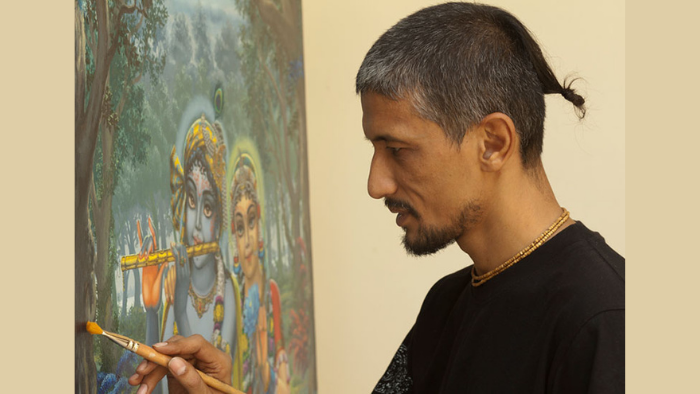When Vrindavan Das read the Bhagavad Gita for the first time in 1992, he began chanting mantras from the very same day. He completed his art degree in P.P Benkov Art College and began shaping his creative research. In 1996, Vrindavan Das was invited to a spiritual art project in India, to paint murals on Krishna and Ram Lila. He was in Vrindavan at the time and considered this art project as a seva to the Divine.
Vrindavan Das spoke to CSP about his journey with art, and India. “When I was introduced to the Vedic culture, I enjoyed it. I turned to the Vedas to acquire more knowledge. It was amazing for me to know that it contains not only philosophy but various aspects of life such as cosmology, astrology, the sixty-four art forms, grammar, medicine, and much more. It begins with the physical body and goes into deeper levels within the soul and the Supreme,” explained Vrindavan.
When Vrindavan was in art school, he had mastered his foundation, and was well equipped with his techniques. But he also felt that as an artist, experience is not enough. An artist also needs inspiration.

“When I completed my diploma, I was under a lot of stress and very uninspired to do art. I almost thought of pursuing another career. But, fortunately that is when I was introduced to many books that spoke of the shastras and the puranas. This inspired, and rekindled my fire to pursue art," reminisced Vrindavan. That is when he started practising Sanatana Dharma.
When he came to India in 1996, he received Diksha (initiation) from his Guru who taught him how to worship Bhagavan and Shakti along with the meaning of holy Granthas or books. Since he was exposed to western art, when he came to India, he came to see the richness of Indian heritage embedded with various styles of architecture, sculpting, and schools that taught miniature and modern contemporary art.
“I began my manasik sadhana on Bhagavan and Shakthi and naturally, my paintings also depicted the two: their forms and their lilas. But, I found it difficult to express bhava (emotion), because a dry and realistic painting without bhava does not attract the mind of a sadhaka. I learnt bhava from Indian traditional miniature art schools, and I combined western realism with Indian miniature art. And, I must say, this combination definitely helped my Manasik Sadhana to visualise the Divine forms,” he elucidated.
To Vrindavan, art and spirituality are one. “Inspiration comes from within and in that very inspiration, I can see Shakti. The sixty-four forms of art come from God, so any form of art is spiritual,” he said. He began worshipping Lakshmi, Radharani and mother Sita, and in 2004, he included Tripura Sundari, another form of Shakti. “This worship means a lot to me because without Shakti, it is difficult to attain Bhagavan in any sadhana, because She is the one who through the Guru and our sadhana removes all kleshas or impurities of the heart, and gives darshan of the holy realm. ,” he explained. Vrindavan has visited a few Shakti Peethas in North India and in Karnataka.
Art is my sadhana because it requires concentration, meditation, bhava, and surrender to the process of art. Without this, it is hard to create spiritual art or any art.
-Vrindavan Das

Sharannavaratri was recently celebrated with grandeur all over the country, and Devi being Vrindavan’s devata, he said, “Navaratri is a good opportunity to surrender to the Holy Mother Adi Shakti and her forms where she takes you as child and cleanses your impurities of heart and removes obstacles and takes you closer to the absolute reality.”
Vrindavan’s art pieces are displayed in museums in Europe and India. His paintings on the Ramayana and Krishna Lilas are displayed in the Museum of Vedic Art. Up until now, his paintings depict Krishna lila, Ram lila, and Shiva Parvati. He has also painted Shree Tripura, Mahakali, Adhya Kali and Smashan Kali. He hopes to paint scenes from the Devi Bhagavata purana in the future.




